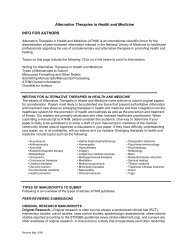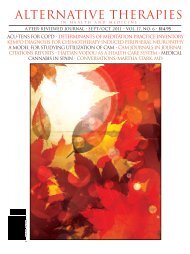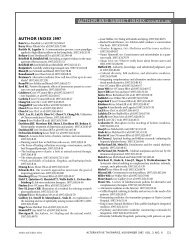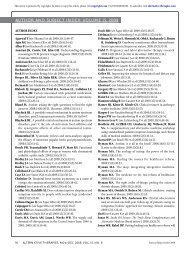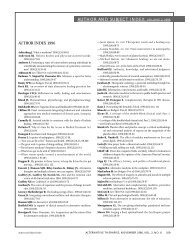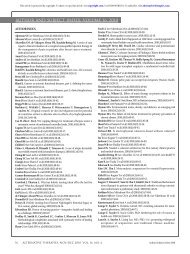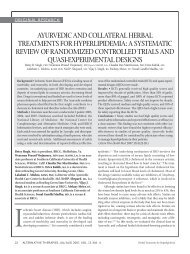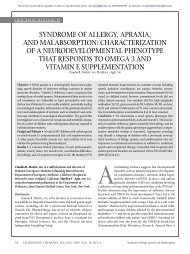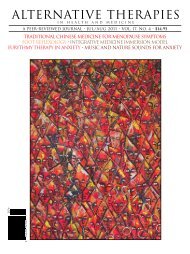Alternative Therapies In Health And Medicine
Alternative Therapies In Health And Medicine
Alternative Therapies In Health And Medicine
Create successful ePaper yourself
Turn your PDF publications into a flip-book with our unique Google optimized e-Paper software.
circulation and promote specific bodily and muscular functions. It<br />
has been estimated that more than 20 million Americans have seen<br />
reports of the effectiveness of reflexology on television and have read<br />
about this natural technique of healing in national magazines and<br />
newspapers. 23 Several books have been written to propagate the rejuvenation<br />
effects of reflexology. 24-26 Though Wang et al 27 reviewed five<br />
studies of reflexology in the literature and concluded that there is no<br />
evidence for any specific effect of reflexology in any conditions with<br />
the exception of urinary symptoms associated with multiple sclerosis,<br />
others have shown significant effects using reflexology. The feet are<br />
the most common areas treated with reflexology. 24 Sudmeier et al 28<br />
showed that foot reflexology (FR) is effective in changing renal blood<br />
flow. Stephenson et al 29,30 have shown that FR can relieve pain in<br />
patients with metastatic cancer and decrease anxiety in patients with<br />
breast and lung cancer. Ergonomically created footwear also has been<br />
invented to provide relaxation, reduce swelling, induce blood flow,<br />
and rejuvenate the muscles and nerves in the ankle and foot area. 31<br />
Since patients with anxiety or pain are expected to have an elevated<br />
sympathetic and a depressed vagal modulation, 32,33 it is possible<br />
that treatment with FR can lower sympathetic modulation and<br />
raise vagal modulation. It is therefore worthy of investigating whether<br />
FR can have an effect on the autonomic nervous modulation in<br />
normal controls and in patients with CAD.<br />
MATERIALS AND METHODS<br />
Study Participants<br />
Coronary arteriography was performed in patients with angina<br />
pectoris, unstable angina, previous myocardial infarction, or other<br />
evidence of myocardial ischemia. A panel of cardiologists interpreted<br />
the angiograms. The coronary arteries and branches were divided<br />
into 15 segments according to the Ad Hoc Committee for Grading of<br />
Coronary Artery Disease of the American Heart Association. 34 Only<br />
the luminal narrowing in the following segments was used in the<br />
final assessment: segment 1-3 for the right coronary artery, segments<br />
6 and 7 for the left anterior descending branch, segments 11 and 12<br />
for the circumflex branch, and segment 5 for the left main coronary<br />
artery. By confining the analysis to these segments alone, only those<br />
patients who had significant obstruction in the main epicardial coronary<br />
arteries were included in this study. Stenosis was considered to<br />
be significant if a luminal narrowing >50% was present. Patients<br />
without stenosis or with luminal narrowing 140 mmHg or diastolic blood pressure >90 mmHg. 35<br />
Hyperlipidemia was defined as total cholesterol >200 mg/dL or low<br />
density lipoprotein cholesterol >100 mg/dL. 36 Patients who had atrial<br />
fibrillation or coexisting valvular heart disease or were using class I<br />
antiarrhythmic medication were excluded from this study. All participants<br />
were requested to refrain from alcohol or caffeine ingestion<br />
24 hours before the study. The hospital <strong>In</strong>stitutional Review Board<br />
approved this study. The procedure was fully explained to the participants,<br />
and written informed consent was obtained from them<br />
before the study.<br />
Equipment<br />
The electrocardiogram (ECG) signals were recorded using a<br />
multichannel recorder (Biopac MP150 with 16 channels, MP150CE/<br />
UIM100C/ECG100C, BIOPAC Systems, <strong>In</strong>c, Goleta, California) from<br />
conventional lead II, and blood pressure was measured by using a<br />
sphygmomanometer (Kenlu-model K-300 Sphygmomanometer, Di<br />
Tai Precision Ent Co Ltd, Kaohsiung City, Taiwan) on each participant<br />
lying in a supine position. The analog signals of ECG were<br />
transformed to digital signals by using an analog-to-digital converter<br />
with a sampling rate of 400 Hz. Systolic blood pressure (SBP), diastolic<br />
blood pressure (DBP), mean arterial blood pressure (MABP),<br />
and pulse pressure (PP) were obtained from each participant before<br />
FR using the sphygmomanometer.<br />
Study Protocol<br />
Before FR, each participant rested in a supine position for 5<br />
minutes, and then 10 minutes of continuous ECG signals and blood<br />
pressure data were recorded. After baseline ECG recording and<br />
blood pressure measurement, the participant received FR for 60<br />
minutes. The ECG recording and blood pressure measurements<br />
were repeated 30 and 60 minutes after FR. All procedures were performed<br />
in a bright and quiet room with a room temperature of 24 o C<br />
to 25 o C and humidity of 54% to 55%.<br />
FR was performed on participants lying in a comfortable<br />
supine position by a certified foot reflexologist from the Taiwan<br />
Association of Reflexology using the techniques of Father Josef ’s<br />
FR. 37 The reflexologist used the thumb and fingers to apply pressure<br />
to stimulate all reflex zones in both feet, which correspond to all<br />
organs, glands, and body parts. The technique of the thumb and fingers<br />
resembles a caterpillar-like action in reflexology. 38 Grapeseed oil<br />
is used during FR to prevent friction and possible discomfort because<br />
it is nonsticky and odorless and absorbs easily into the skin. 39,40<br />
Heart Rate Variability Analysis<br />
R-wave–detecting software written with the help of Matlab R13<br />
software (MathWorks <strong>In</strong>c, Natick, Massachusetts) was used to identify<br />
the peaks of the R waves in the recorded ECG signals. The RR<br />
intervals (the time intervals between two consecutive R waves in the<br />
electrocardiogram, RRI) were then calculated after eliminating ectopic<br />
beats. If the percentage of ectopic beats was greater than 5%, then<br />
the participant was excluded from analysis. The last 512 stationary<br />
RRI were used for HRV analysis.<br />
The mean, standard deviation (SD RR<br />
) and coefficient of variation<br />
(CV RR<br />
) of the 512 stationary RRI were calculated using a standard<br />
formula for each participant. The power spectra of RRI were<br />
obtained by means of fast Fourier transformation (Mathcad,<br />
Mathsoft <strong>In</strong>c, Cambridge, Massachusetts). Direct current component<br />
was excluded before the calculation of the powers. The area<br />
under the curve of the spectral peaks within the range of 0.01-0.4 Hz,<br />
0.01-0.04 Hz, 0.04-0.15 Hz, and 0.15-0.40 Hz were defined as the<br />
Foot Reflexology in Coronary Artery Disease<br />
ALTERNATIVE THERAPIES, jul/aug 2011, VOL. 17, NO. 4 9



